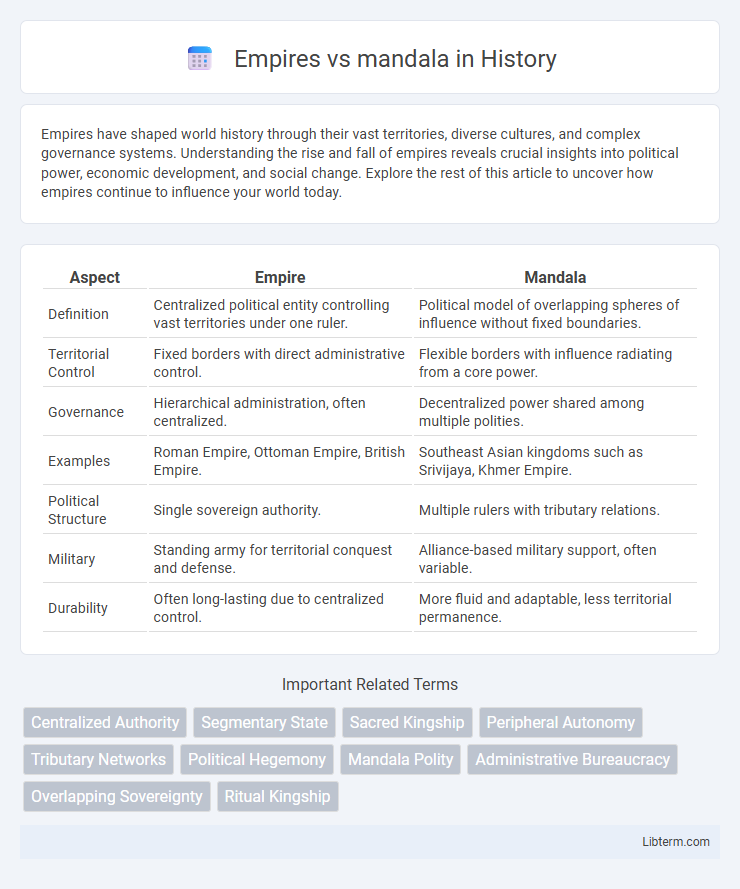Empires have shaped world history through their vast territories, diverse cultures, and complex governance systems. Understanding the rise and fall of empires reveals crucial insights into political power, economic development, and social change. Explore the rest of this article to uncover how empires continue to influence your world today.
Table of Comparison
| Aspect | Empire | Mandala |
|---|---|---|
| Definition | Centralized political entity controlling vast territories under one ruler. | Political model of overlapping spheres of influence without fixed boundaries. |
| Territorial Control | Fixed borders with direct administrative control. | Flexible borders with influence radiating from a core power. |
| Governance | Hierarchical administration, often centralized. | Decentralized power shared among multiple polities. |
| Examples | Roman Empire, Ottoman Empire, British Empire. | Southeast Asian kingdoms such as Srivijaya, Khmer Empire. |
| Political Structure | Single sovereign authority. | Multiple rulers with tributary relations. |
| Military | Standing army for territorial conquest and defense. | Alliance-based military support, often variable. |
| Durability | Often long-lasting due to centralized control. | More fluid and adaptable, less territorial permanence. |
Understanding Empires: Definition and Characteristics
Empires are extensive political formations characterized by centralized authority controlling diverse territories and populations under a single sovereign power, often established through conquest and expansion. Key characteristics include hierarchical governance, cultural pluralism, and economic integration, enabling empires to manage vast regions and varied peoples. Understanding empires involves examining their complex administrative structures, military dominance, and the ability to impose cultural and political order across multiple ethnic and social groups.
The Mandala Model: Origins and Key Features
The Mandala Model originates from ancient Southeast Asian political theory, emphasizing a decentralized, concentric approach to governance where power radiates outward in rings rather than centralized control. Key features include overlapping spheres of influence among kingdoms, flexible alliances, and a focus on tributary relationships rather than fixed borders. This contrasts with empire-centric models by prioritizing relational diplomacy and cultural integration over territorial conquest.
Historical Contexts: Empires and Mandalas in Southeast Asia
Empires in Southeast Asia, such as the Khmer Empire and Srivijaya, expanded through centralized authority and territorial conquest, establishing direct control over vast regions. In contrast, the mandala system emphasized fluid, overlapping networks of power where influence radiated from a central polity to peripheral areas without strict borders. This model reflected the region's complex trade routes, diverse ethnic groups, and the importance of diplomacy and alliances over permanent military occupation.
Political Structures: Centralized vs Diffused Authority
Empires typically feature centralized authority with a strong, hierarchical government that consolidates power in a singular ruler or elite class, enabling coordinated decision-making and control over vast territories. Mandalas, by contrast, exhibit diffused authority through a network of semi-autonomous regional leaders who maintain local sovereignty while recognizing a central hegemon's influence, creating a flexible and overlapping political structure. This distinction in political organization impacts governance, resource distribution, and loyalty dynamics within empires versus mandalas.
Territorial Boundaries: Fixed Borders vs Fluid Spheres
Empires are characterized by fixed territorial boundaries established through treaties, conquest, and formal administration, ensuring clear control over specific lands. In contrast, mandala political systems emphasize fluid spheres of influence with overlapping zones where power is shared or negotiated among neighboring states. This difference in territorial concepts impacts governance, diplomacy, and conflict resolution, with empires asserting rigid sovereignty while mandalas adapt through flexible and dynamic territorial relations.
Power Dynamics: Sovereignty and Vassalage
Empires exhibit centralized sovereignty with direct control over vast territories and diverse populations, whereas mandalas operate through decentralized power networks where authority is exercised via vassalage and tributary relationships. In mandalas, sovereignty is fluid and relational, relying on personal ties and ritual obligations rather than fixed administrative boundaries. This contrast shapes distinct power dynamics, as empires enforce hierarchical governance while mandalas depend on negotiated allegiances and shared influence among local rulers.
Cultural Integration and Influence
Empires facilitated cultural integration by imposing centralized governance and spreading dominant languages, religions, and legal systems across diverse populations, fostering a unified identity. Mandala political structures emphasized fluid, overlapping spheres of influence where local customs and traditions persisted, allowing for a dynamic exchange and mutual adaptation of cultural practices. This flexible model promoted cultural pluralism and localized authority, contrasting with the homogenizing tendencies of empire-building.
Governance and Administration Systems
Empires often developed centralized governance structures with hierarchical bureaucracies to maintain control over vast territories, utilizing appointed governors and standardized legal codes. Mandalas, prevalent in Southeast Asia, relied on decentralized and flexible political systems where sovereignty was based on personal allegiance to a ruler rather than fixed territorial boundaries. Administrative power in mandalas fluctuated with the strength of the central authority, creating a network of semi-autonomous polities linked through tribute and diplomacy rather than direct control.
Decline and Transformation: Empires and Mandalas Over Time
Empires often experience decline due to centralized administrative inefficiencies and rigid territorial control, leading to fragmentation and loss of cohesion over time. Mandalas, characterized by flexible, overlapping spheres of influence and decentralized authority, undergo transformation through dynamic alliances and shifting power centers rather than outright collapse. Historical examples like the Gupta Empire's fall contrast with the sustained adaptability of Southeast Asian mandala polities, highlighting differing trajectories in political evolution.
Legacy and Modern Implications
Empires have shaped the modern world through centralized power structures and territorial expansion, leaving legacies evident in national borders, legal systems, and global trade networks. Mandala models, emphasizing spheres of influence and fluid boundaries, influence contemporary diplomatic strategies and regional cooperation in Southeast Asia. Understanding these frameworks provides insight into current geopolitical alliances and conflicts, reflecting enduring patterns of governance and cultural integration.
Empires Infographic

 libterm.com
libterm.com